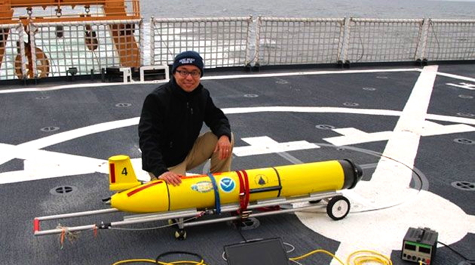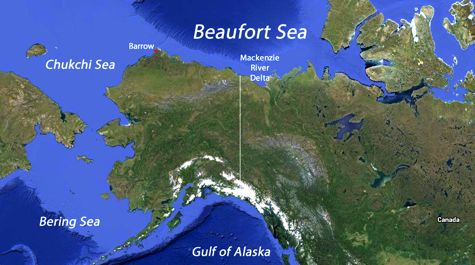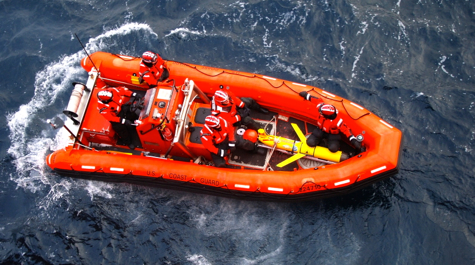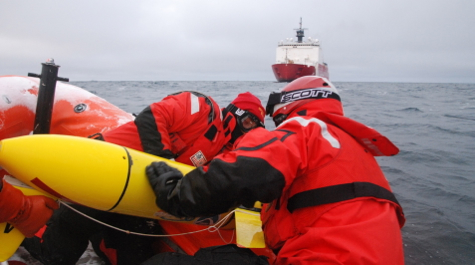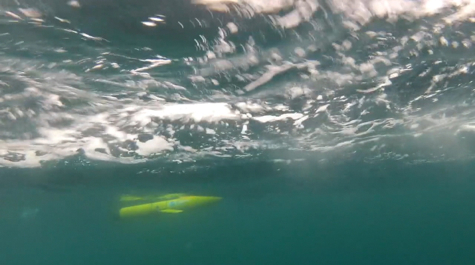VIMS part of international team selected to lead Arctic study
Scientists from US and Canada to explore marine ecosystem of far north
A research team from the Virginia Institute of Marine Science will take part in a long-term, international study of the Arctic marine ecosystem along the Beaufort Sea shelf from Barrow, Alaska to the Mackenzie River delta in Canadian waters.
The Marine Arctic Ecosystem Study, or MARES, stems from increased attention to climate change, energy development, and sustainability in the Arctic region. Information gained will aid government, industry, and communities in making decisions related to regulations, resource management, economic development, and environmental-protection issues.
MARES is coordinated and planned by the U.S. Interior Department’s Bureau of Ocean Energy Management, in conjunction with its federal and private-sector research partners. Leading the project is Stantec Consulting Services, Inc., with guidance from an independent scientific review board. The project is planned for at least five years (2014 to 2019).
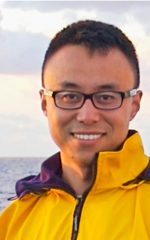 Professor Donglai Gong, who leads the VIMS component of the project, says “We’re excited to be part of this groundbreaking interdisciplinary study in the U.S. and Canadian Arctic. The knowledge we gain from MARES will help us make more informed decisions when coping with the rapidly changing Arctic environment and managing the sustainable use of Arctic resources.” Average winter temperatures in the Arctic have warmed by more than 7°F in during the last 50 years, while the extent of Arctic sea ice has decreased by more than 30% since satellite records began in 1979.
Professor Donglai Gong, who leads the VIMS component of the project, says “We’re excited to be part of this groundbreaking interdisciplinary study in the U.S. and Canadian Arctic. The knowledge we gain from MARES will help us make more informed decisions when coping with the rapidly changing Arctic environment and managing the sustainable use of Arctic resources.” Average winter temperatures in the Arctic have warmed by more than 7°F in during the last 50 years, while the extent of Arctic sea ice has decreased by more than 30% since satellite records began in 1979.
VIMS Dean and Director John Wells says, “Participation by Donglai and his graduate students in this project demonstrates the international scope of VIMS’ research, and has important implications for local issues such as sea-level rise and maritime and naval operations in a predicted ice-free Arctic.”
VIMS will provide scientific support for MARES by deploying underwater gliders along the Beaufort shelf. The VIMS gliders will use optical and acoustic sensors to make high-resolution measurements of the region’s physical and biological characteristics. These will complement data from ships and moored platforms, together providing crucial data for validating the skill of computer models. The overall goal of the project is to better understand the coupling between physical processes and food-web dynamics in the shallow waters of the Beaufort Sea.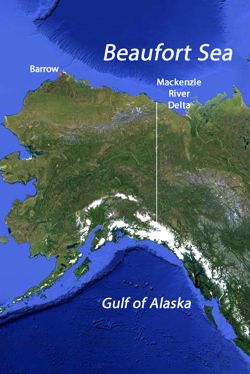
“By employing new observational tools and methods, we’ll significantly increase the amount of information we have for this remote but crucial region of the Arctic,” says Gong. “We expect a challenging operational environment but my team is ready and we look forward to getting started.”
Public/Private Partnership
Joining the Bureau of Ocean Energy Management in coordinating and planning MARES are the U.S. Arctic Research Commission, U.S. Coast Guard, U.S. Geological Survey, U.S. Integrated Ocean Observing System, Marine Mammal Commission, National Science Foundation, National Oceanic and Atmospheric Administration, Office of Naval Research, and Shell Oil Company.
BOEM Acting Director Walter Cruickshank says “BOEM is pleased to join our Federal and industry partners to undertake this forward-looking project. With widespread interest in the Artic, including potential oil and gas leasing and development, we’re looking to significantly expand our knowledge of the Beaufort Sea ecosystem to inform our decision-making.”
Study Goals
The overarching goal of the study is to better understand the interrelationships of the region’s physical, biological, chemical, and human systems—including traditional knowledge of the Beaufort Sea—and to advance scientific prediction capabilities for linkages between marine life, human uses, sea ice, atmospheric and oceanic processes, and river discharge.
The research is being undertaken under the National Oceanographic Partnership Program (NOPP), which leverages resources from federal agencies, academia, industry and non-governmental organizations to support ocean research. It is important for BOEM and its NOPP partners to study and monitor areas known for high biological productivity and prevalent subsistence use to ensure their protection.
Over the course of the study, the team will use multiple sampling platforms, including ships, drones, satellites, and snow machines; multiple sampling techniques such as ice and snow sensors, acoustics, and nets; as well as multiple ocean, ice, and air modeling approaches.
The study results will inform several research areas including environmental protection, climate change, food security, biodiversity, exploration and discovery, and ecosystem services (the contributions that a biological community and its habitat provide to our day-to-day lives).
About Stantec
Founded in 1954, Stantec Inc. provides professional consulting services in planning, engineering, architecture, interior design, landscape architecture, surveying, environmental sciences, project management, and project economics for infrastructure and facilities projects. The Company provides services on projects around the world through more than 14,000 employees operating out of more than 230 locations in North America and 7 locations internationally.
About BOEM
BOEM promotes energy independence, environmental protection, and economic development through science-based management of offshore conventional and renewable energy and marine mineral resources. BOEM’s Environmental Services Study Program develops, funds, and manages scientific research to inform policy decisions regarding the development of energy and mineral resources on the Outer Continental Shelf.


